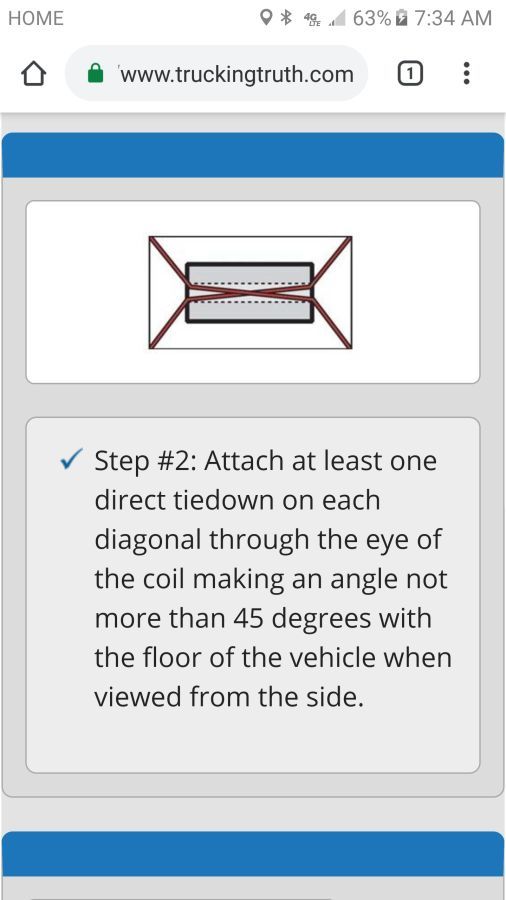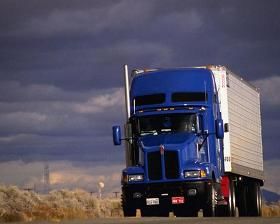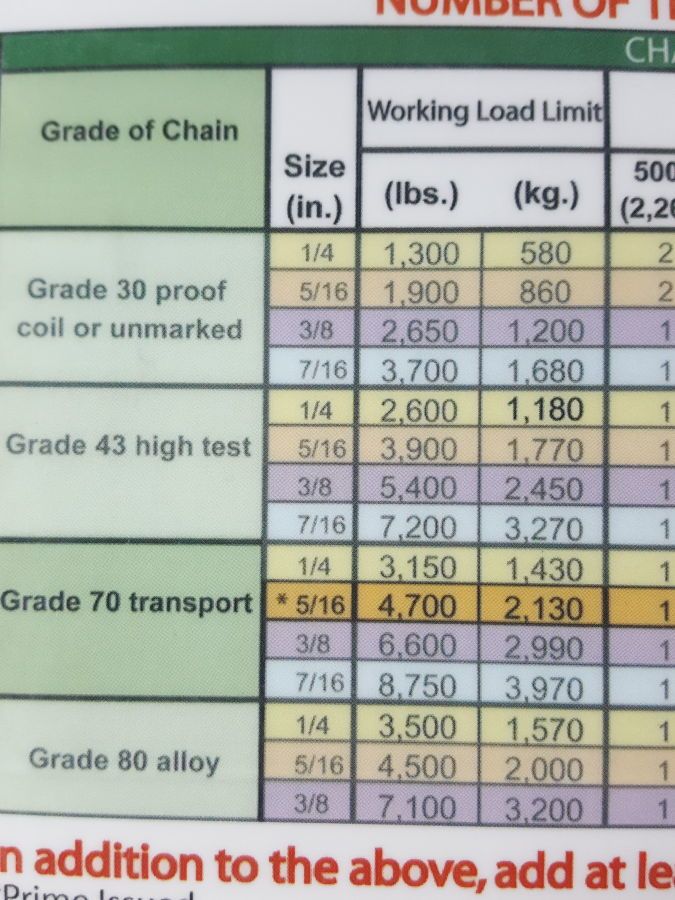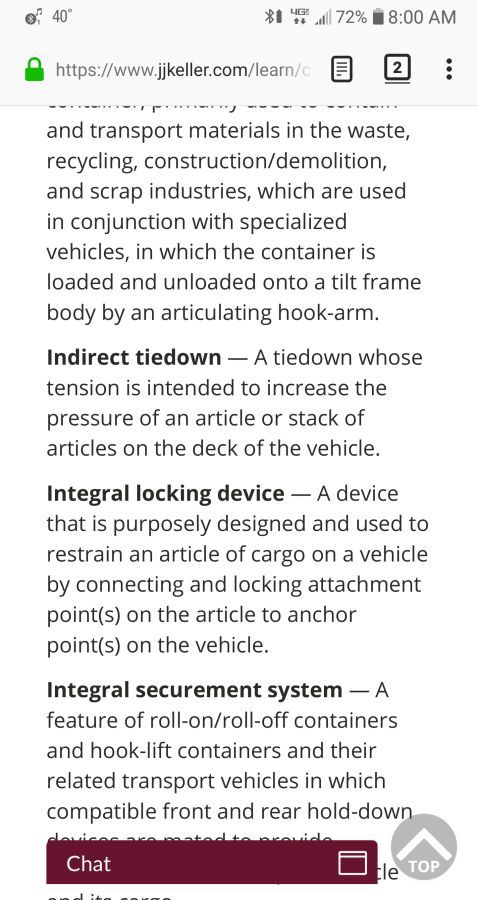Metal Coil Frustration.
Topic 24476 | Page 2
Taken directly from the HRTP: this is why I say it's direct.

Yeah the wording is indeed tricky. That's why I say answer C is correct. Depending on the weight of the coil, and rating of the straps, answer C could be legal.

This should give you everything you need to know about coils.
CSA:
Compliance, Safety, Accountability (CSA)
The CSA is a Federal Motor Carrier Safety Administration (FMCSA) initiative to improve large truck and bus safety and ultimately reduce crashes, injuries, and fatalities that are related to commercial motor vehicle
FMCSA:
Federal Motor Carrier Safety Administration
The FMCSA was established within the Department of Transportation on January 1, 2000. Their primary mission is to prevent commercial motor vehicle-related fatalities and injuries.
What Does The FMCSA Do?
- Commercial Drivers' Licenses
- Data and Analysis
- Regulatory Compliance and Enforcement
- Research and Technology
- Safety Assistance
- Support and Information Sharing
DOT:
Department Of Transportation
A department of the federal executive branch responsible for the national highways and for railroad and airline safety. It also manages Amtrak, the national railroad system, and the Coast Guard.
State and Federal DOT Officers are responsible for commercial vehicle enforcement. "The truck police" you could call them.
Fm:
Dispatcher, Fleet Manager, Driver Manager
The primary person a driver communicates with at his/her company. A dispatcher can play many roles, depending on the company's structure. Dispatchers may assign freight, file requests for home time, relay messages between the driver and management, inform customer service of any delays, change appointment times, and report information to the load planners.

Looking on the fmcsa regulations the word "direct" is not used.
Brett, I think that needs to be changed on the high road because it is in conflict with the definition of a direct tie-down.
CSA:
Compliance, Safety, Accountability (CSA)
The CSA is a Federal Motor Carrier Safety Administration (FMCSA) initiative to improve large truck and bus safety and ultimately reduce crashes, injuries, and fatalities that are related to commercial motor vehicle
FMCSA:
Federal Motor Carrier Safety Administration
The FMCSA was established within the Department of Transportation on January 1, 2000. Their primary mission is to prevent commercial motor vehicle-related fatalities and injuries.
What Does The FMCSA Do?
- Commercial Drivers' Licenses
- Data and Analysis
- Regulatory Compliance and Enforcement
- Research and Technology
- Safety Assistance
- Support and Information Sharing
Fm:
Dispatcher, Fleet Manager, Driver Manager
The primary person a driver communicates with at his/her company. A dispatcher can play many roles, depending on the company's structure. Dispatchers may assign freight, file requests for home time, relay messages between the driver and management, inform customer service of any delays, change appointment times, and report information to the load planners.Option #1 and #2 both require a side-to-side tiedown over the top also. Option #3 allows only 2 indirect tiedowns to be in compliance. So from the answer choices given, I stand by my answer that C is correct. If I'm missing something I apologize for the confusion.
I agree that the definition of direct and indirect needs to be better defined.
From the FMCSA definition of a direct tie down:
"One end of a direct tie down is attached to the cargo itself."
That's an important distinction. I'm glad you posted that because it alters my definition of what a direct tie down is.
I was taught that a direct tie down directly opposes a force (side, forward, rearward) by providing opposite resistance. Like when I X-cross my straps in front of a load of shingles for example, to prevent forward shift.
An indirect tie down was taught to me as one providing straight downward pressure to the deck to oppose all forces.
So with that FMCSA definition, I stand corrected. But I'm sticking with my answer.

CSA:
Compliance, Safety, Accountability (CSA)
The CSA is a Federal Motor Carrier Safety Administration (FMCSA) initiative to improve large truck and bus safety and ultimately reduce crashes, injuries, and fatalities that are related to commercial motor vehicle
FMCSA:
Federal Motor Carrier Safety Administration
The FMCSA was established within the Department of Transportation on January 1, 2000. Their primary mission is to prevent commercial motor vehicle-related fatalities and injuries.
What Does The FMCSA Do?
- Commercial Drivers' Licenses
- Data and Analysis
- Regulatory Compliance and Enforcement
- Research and Technology
- Safety Assistance
- Support and Information Sharing
Fm:
Dispatcher, Fleet Manager, Driver Manager
The primary person a driver communicates with at his/her company. A dispatcher can play many roles, depending on the company's structure. Dispatchers may assign freight, file requests for home time, relay messages between the driver and management, inform customer service of any delays, change appointment times, and report information to the load planners.
@ Brett Aquila
Do I have to Be signed in for that to count toward some record?
@ Chris M
I think the answer to question 3 is “ H “ , a friend pointed it out to me once he looked back on the booklet and told me he instant failed by selecting G 70.
Also I have hauled a 53” Van, the insides are metal and the floor is wood. I can’t picture the coil in the vertical position being secured to anything. That trailer had flimsy pieces of wood to secure it, sorry it just doesn’t seem feasible. It doesn’t have anything on the floor to wrap a chain through.
@ ∆_Danielsahn_∆
Thank you, exactly my point.
@ LDRSHIP
But I have taken other ones that I absolutely will not use “ P “ , “ S “ , “ W “ ( actually have a slight curiosity about towing ). I am just waiting to slap them onto the license.
Also I can’t survive in another state, I have delivered to a few of them and they just lack the abuse nyc happens to have. Keeps you on edge.
OWI:
Operating While Intoxicated

Https://1drv.ms/f/s!Ai9GRFbqA1BwhSKXurppGaaYWz5U
The booklet says one Direct tie down on each diagonal. ( Securement option one ). Looks like it’s forming an “ X “.
But I thought a direct tie down was attached to the article / cargo itself.
As far as I understand Indirect means over the article / cargo with 50% Tension downwards.
As for the screen shot, I picked half when I was doing the “ practice test “ questions that somehow didn’t register.
So it’s 50% or not. Still kinda confused.
I don't have much time before I gotta roll so I'll be quick.
Question 3 on the chains:
3. 3/8 chain is rated with 5,400 lbs. the chain should have a rating of? ( the chart is on page 2.8 of the booklet )
A. G70 B. H C. HT

3/8 chain rated at 5400lbs is Grade 43 High Test (HT)
Question 4- regardless of the definition of direct or indirect, answers A and B can't possibly be correct because they must also include a side to side tie down going directly over the top of these coil to be in compliance. Look at the link above on coil securement that Chris M sent. It shows 3 options for securing a shotgun coil. Answer C is the only one that matches one of those options (option #3).
HOS:
Hours Of Service
HOS refers to the logbook hours of service regulations.New Reply:
New! Check out our help videos for a better understanding of our forum features

















Preview:
This topic has the following tags:
Advice For New Truck Drivers CDL Endorsements CDL Exam Flatbed NYC Understanding The Laws









 TT On Facebook
TT On Facebook
Hey Turtle, in the case of "X" chains on a shotgun coil, they are indirect. In order for them to cross, they would have to each be connected to opposite sides of the trailer. If they didn't cross, they would be horseshoe, which would be direct because both ends would be connected to the same side of the trailer.
I do agree that the wording, if correct on that question, is trying to fool you because the chains couldn't possibly be parallel and still be indirect.